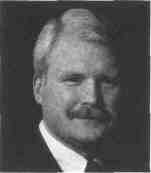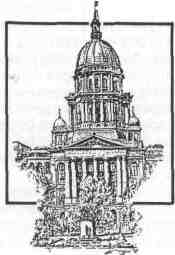The election battle to watch in November was the one for control of the Illinois House of Representatives. The Republicans swept to victory and added thirteen new seats to their side of the aisle. In January sixty-four Republicans and fifty-four Democrats will be sworn in making Lee A. Daniels the next Speaker of the House of Representatives. A number of seats, both in the House and Senate, went uncontested. Of the twenty-one Senate seats up for election only thirteen were contested with six Democrats and two Republicans having no opposition. In addition, there were thirty-eight Senators in the middle of four year terms who did not run for election. Sixteen of those are Democrats and twenty-two are Republicans. Republican control of the Senate increased by the addition of one seat so now Senate President James "Pate" Philip has a thirty-three to twenty-six majority. In the House eighty-two races included candidates from both parties. In twenty districts Democrats had no opposition and in sixteen others Republicans ran unopposed. Of the eighty-two contests, thirty-six have Democrat incumbents and thirty-two have Republican incumbents and fourteen have no incumbents. Democratic incumbents lost in twelve races and Republicans won in three of the remaining contested races giving Republicans a majority in the House of Representatives for the first time since George Ryan was Speaker in 1981. Republicans also swept all six constitutional offices in the November contest.
WHITE HOUSE CONFERENCE
ON AGING 1995
The terms of the Older Americans Act Amendments of 1992 state that a 25-member policy committee be chosen jointly by the President and the Congress to plan the specifics of the White House Conference on Aging, including its agenda and participants. In October 1993, President Clinton appointed Robert B. Blancato, the former staff director of the House Select Committee on Aging Subcommittee on Human Services, to serve as the Executive Director of the White House Conference on Aging. The Congress, in authorizing the Older Americans Act Amendment, specifically defined the purpose of the Conference to include: increasing public awareness of the interdependence of generations and the essential contributions of older individuals; examining common problems facing the generations; developing specific and comprehensive recommendations for executive and legislative action appropriate for maintaining and improving the well-being of older adults; developing recommendations for the coordination of Federal policy with State and local needs; and reviewing the recommendations adopted at previous White House Conferences on Aging. Throughout 1994 and culminating in May 1995, the White House Conference on Aging will be coordinating the development of local, state and regional conferences on aging, as well as conducting select mini-conferences on specific policy issues and specific constituencies. 10 Illinois Parks & Recreation November/December 1994
IAPD LEGISLATIVE PROGRAM PAYS DIVIDENDS
GOVERNOR AWARDS In October, Governor Jim Edgar awarded nearly $2.1 million to 23 communities, funding 40 miles of bicycle paths that will provide expanded recreational opportunities and important transportation links. More than 300 miles of trails have been funded since the inception of the bicycle path grant program five years ago, which grew out of legislation passed in cooperation with the Illinois Association of Park Districts. The Department of Conservation, which administers the program, received 35 applications for funding this year, with a combined request of nearly $3.2 million. The grants are available to any local government having statutory authority to acquire and develop land for public recreation. Grants are funded from a percentage of motor vehicle title transfer fees and provide up to 50 percent of an approved project's total cost. Grants to development projects are limited to $200,000. There is no cap for acquisition projects. Applications for the next cycle of grants will be accepted January 1 through March 1,1995. IAPD Members Receiving 1994 Bicycle Path Grants include: Chicago Park District $ 182,000 to rehabilitate and extend the heavily used one-mile lakefront bicycle path between Oak Street and Grand Avenue. The project will enhance bicyclist and pedestrian access to Navy Pier and Olive Park from the west side of Lake Shore Drive. DeKalb County Forest Preserve District $171,500 to link the four-mile DeKalb Park District/Kiwanis trail system north about six miles to the City of Sycamore, via Commonwealth Edison and county highway rights-of-way. The trail will be routed through Sycamore to the 17-mile Great Western Trail which travels east to St. Charles. Frankfort Park District $20,400 to construct a .5 mile bicycle path through Main Park, in the southwest comer of town, which will then run north one block to connect with the more than 20-mile Old Plank Road Trail. Geneva Park District $21,000 to renovate a heavily used portion of the Fox River Trail at Bennett Park just north of State Street on the east side of the river in Geneva and provide parking and access for disabled trail users. Kane County Forest Preserve District $133,400 to expand the 14-mile V.L. Gilman Trail, a dedicated "national recreational trail," 1.3 miles to link Waubonsee College directly with the city of Aurora. The trail will pass through Bliss Woods Forest Preserve and run along Blackberry Creek. Kankakee Valley Park District $41,800 to extend the Bourbonnais Township Park District's existing 3.9 mile trail through Perry Farm Park along the Kankakee River south .5 miles through Lavasseur Park in Kankakee to the YMCA. Lake County Forest Preserve District$200,000 to construct 1.5 miles of bicycle trail along the southern portion of the Des Plains River in Lake County. This section is part of the district's designated 33-mile cross country trail of which 19 miles are completed. Morton Park District $46,100 to develop two miles of bicycle path from Morton to the Fon du Lac Park District trail in East Peoria at Morton's western corporate limits, giving Morton residents access to more than seven miles of trails. Peoria Park District/City of Peoria$149,500 to provide 2.5 miles of bicycle path from Deweiler Marina to Glen Oak Park and through Springdale Cemetery. Richton Park Parks and Recreation Department $62,100 to construct about 1.5 miles of 10-foot-wide asphalt as phase I of a community-wide bike trail system linking Glaeser Park, Rich South High School, Sauk School and the municipal building. The project consists of a trail from Sauk School north to the village limits along an existing pipeline corridor and an intersecting trail along Poplar Avenue from Cicero Avenue to Governor's Highway. This trail will eventually link up with the more than 20 mile Old Plank Road in Matteson. Rockford Park District $91,600 to construct a pedestrian/bicycle bridge across the Rock River. This bridge provides the missing link in the Rock River Recreation Path which runs seven miles from downtown Rockford to the Machesney Park Mall and connects at the northern terminus to the three-mile-long Sportscore Bicycle Trail. Round Lake Area Park District $ 16,500 to extend the park district's existing two-mile Gateway Trail about .5 miles west from Cedar Lake Road to Sunset Drive in the village of Round Lake Beach. St. Charles Park District/Kane County Forest Preserve District $136,600 to provide a 3.5 mile corridor between the Fox River Trail and the Great Western Trail. The bicycle path will run south from Silver Glen Road, along Randall Road on a county highway easement, to Leroy Oakes Forest Preserve. It will connect there with the Great Western Trail, which runs west 17 miles to Sycamore. Illinois Parks & Recreation November/December 1994 11
NATIONAL ISSUES
THE CRIME BILL The Violent Crime Control and Law Enforcement Act was signed into law by President Clinton on September 13,1994 (Public Law 103-322). The $30.2 billion package includes about $5.5 billion in prevention funding, of which NRPA estimates about $3 billion potentially could be available for public recreation and park endeavors. The following summarizes those programs most likely of interest to public park and recreation systems. Unless otherwise noted these programs are first eligible for appropriations in fiscal year 1996.
Community Schools Youth Services and
Supervision Grant Program
Total Authorized Amount: $567 million
Urban Recreation and At-Risk Youth Act
Total Authorized Amount: $4.5 million
Local Crime Prevention Block Grant
Total Authorized Amount: $377 million
Prevention of Crime in Public Parks
Total Authorized Amount: $15 million
|
|||||||||||||||||||||
|
Sam S. Manivong, Illinois Periodicals Online Coordinator |


